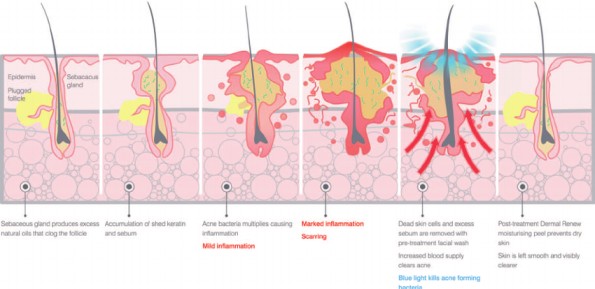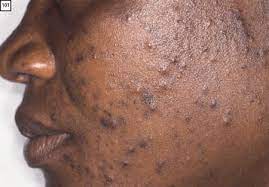Table of Contents
ToggleAcne Vulgaris
Acne Vulgaris is an inflammatory skin disease caused by changes in the pilosebaceous units (skin structures comprising a hair follicle and its related sebaceous gland) of the skin.
The term acne comes from a Greek word acme meaning a skin eruption)
Acne vulgaris is the most common cutaneous disorder affecting adolescents and young adults. Patients with acne can experience significant psychological morbidity and, rarely, mortality due to suicide.
The psychological effects of embarrassment and anxiety can impact the social lives and employment of affected individuals.
Scars can be disfiguring and lifelong.

Classification of Acne
It is classified as mild, moderate, or severe.
Mild acne is defined as non-inflammatory lesions (comedones), a few inflammatory (papulopustular) lesions, or both.
Moderate acne is defined as more inflammatory lesions, occasional nodules, or both, and mild scarring.
Severe acne is defined as widespread inflammatory lesions, nodules, or both, and scarring, moderate acne that has not settled with 6 months of treatment, or acne of any “severity” with serious psychological upset.
Causes of Acne Vulgaris
Acne occurs by hypersensitivity of the sebaceous glands to a normal circulating level of androgens, which are aggravated by P. acnes and inflammation.
Causes of acne include the following:
- Propionibacterium acnes infection, Staphylococcus epidermidis
- Use of medications like lithium, steroids, and anticonvulsants
- Exposure to excess sunlight
- Use of occlusive wear like shoulder pads, headbands backpacks, and underwire brassieres
- Endocrine disorders like polycystic ovarian syndrome and even pregnancy
- Accumulation of dead skin cells.
- Any medication containing halogens (iodides, chlorides, bromides), lithium, barbiturates, or androgens.
- Conditions like Congenital adrenal hyperplasia, Cushing’s syndrome, polycystic ovary syndrome
- Puberty

Pathophysiology of Acne
Four factors are involved:
- Follicular hyper keratinization .
- Increased sebum production .
- Propionic bacterium acnes (P. acnes) within the follicle. An anaerobic diphtheroid that is a normal component of skin flora.
- Inflammation.
During puberty, under the influence of androgens, sebum secretion is increased as 5-alpha reductase converts testosterone to more potent DHT, which binds to specific receptors in the sebaceous glands increasing sebum production. This leads to an increased hyperproliferation of follicular epidermis, so there is retention of sebum.
Distended follicles rupture and release pro-inflammatory chemicals into the dermis, stimulating inflammation.
C. acnes, Staphylococcus epidermis, and Malassezia furfur induce inflammation and induce follicular epidermal proliferation
Risk Factors
- Role of androgens — stimulating the growth and secretory function of sebaceous glands.
- External factors — Soaps, Oil-based cosmetics and facial massage, detergents, Repetitive mechanical trauma caused by scrubbing with these agents may worsen the disorder by rupturing comedos, promoting the development of inflammatory lesions. Thus, patients with acne should refrain from rubbing their faces or picking their skin.
- Turtlenecks, bra straps, shoulder pads, orthopedic casts, and sports helmets cause acne mechanical, in which occlusion of pilosebaceous follicles leads to comedone formation.
- Diet — The natural hormonal components of milk or other bioactive molecules in milk could exacerbate acne.
- Family history — Individuals with close family members with acne are at increased risk for the disorder. Has a more than three-fold risk among individuals with affected first-degree family members.
- Stress — Psychological stress can exacerbate acne. Receptors for corticotrophin releasing hormone (CRH), a hormone involved in the stress response, are present in human sebaceous glands. Severe anxiety and anger may aggravate acne, probably by stimulating stress hormones.
- Body mass index — There is an association between rising BMI and increased risk for acne only among females
- Premenstruation — A premenstrual flare-up in acne seems to follow edema of the pilosebaceous duct. This occurs in 70% of female patients.
Signs and symptoms of Acne.
- Acne vulgaris typically affects those areas of the body that have the largest, hormonally-responsive sebaceous glands, including the face, neck, chest, upper back, and upper arms.
- Typical lesions of acne vulgaris (e.g, open comedones, closed comedones, and inflammatory lesions),
- Scarring
- Post inflammatory hyperpigmentation is common in patients with darker complexions, and take several months or more to resolve without treatment.
- Adult women present with acne involving the lower face and neck that is often associated with premenstrual flares.
Management of Acne Vulgaris
Aims
- To reduce bacterial colonies.
- To decrease sebaceous gland activity, prevent the follicles from becoming plugged.
- Reduce inflammation, combat secondary infection.
- To minimize scarring and eliminate factors that predispose the person to acne.
Medical Management
Topical Pharmacologic Therapy
- Benzoyl peroxide 5% Topical bid
- Topical antibiotics e.g. Clindamycin 1% gel
Systemic Pharmacologic Therapy
- Antibiotics e.g. Doxycycline 100 mg PO bid
- Oral Retinoids
- Hormone Therapy, Oral contraceptives: May help in women; estrogen decreases androgens and thereby suppresses sebum secretion.
Surgical treatment
- Extraction of comedo contents
- Drainage of pustules and cysts
- Excision of sinus tracts and cysts
- Intralesional corticosteroids for anti-inflammatory action
- Cryotherapy
- Dermabrasion for scars
- Laser resurfacing of scars
Nursing Diagnosis
- Impaired skin integrity
- Deficient knowledge
- Disturbed body image
Nursing Management
- Administer prescribed medications, which may include acne products containing benzoyl peroxide (explain that these products initially cause skin redness and scaling but that the skin adjusts quickly); topical agents, such as vitamin A acid; and antibiotics such as tetracycline.
- Provide client and family teaching
o Advise the client that heat, humidity, and perspiration exacerbate acne. Explain that uncleanliness, dietary indiscretions, menstrual cycle, and other myths are not responsible for acne.
o Explain that it will take 4 to 6 weeks of compliance with the treatment regimen to obtain results.
o Instruct the client to wash his face gently (do not scrub) with mild soap twice daily.
o Instruct the client not to squeeze blackheads, not to prop hands on or rub the face, to wash hair daily and keep it off the face, and to use cosmetics cautiously because some may exacerbate acne.
o Instruct the female client to inform her health care provider if she is possibly pregnant. Some medication, such as systemic retinoic acid, have teratogenic effects, therefore a pregnancy test is required prior to treatment and strict birth-control measures are use throughout pregnancy.


Besides classifications are there types of acne . Thanks for the work